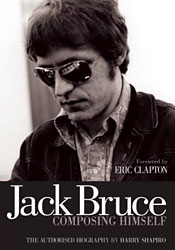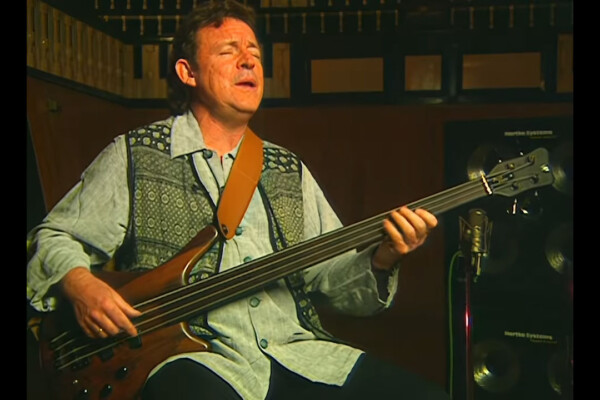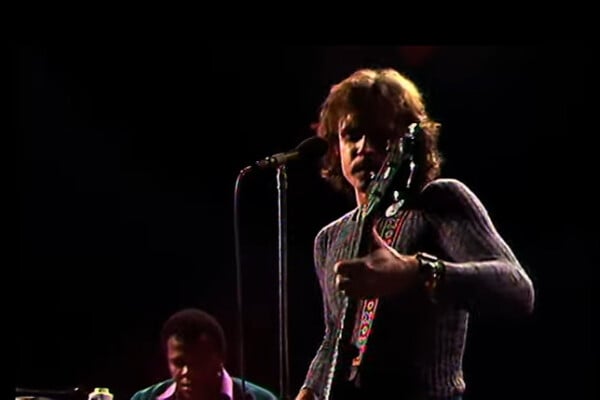Book Review: Jack Bruce Composing Himself – The Authorized Biography
 When word reached me that Harry Shapiro’s just released biography on Jack Bruce was available I raced to the bookstore. What a satisfying read; not the typical star worshipping pabulum one might expect in a biography focused on the life of a man who changed the face of rock and electric bass playing 40 odd years ago.
When word reached me that Harry Shapiro’s just released biography on Jack Bruce was available I raced to the bookstore. What a satisfying read; not the typical star worshipping pabulum one might expect in a biography focused on the life of a man who changed the face of rock and electric bass playing 40 odd years ago.
Interesting early highlights focus on Jack’s family background, which include a move from Glasgow to Canada early in life only to return in worse circumstances than when they left. Bruce’s parents were politically far to the left and he had a doting mother who did all she could to help Jack get a start in life that well positioned him to get top flight musical instruction.
In 1958, when he was 15, Jack won a part-time scholarship to the Royal Scottish Academy of Music and Drama. There he would continue his cello studies and composing where he didn’t quite fit in; he was interested in jazz and his working class background further identified him as a sort of square peg in a round hole.
Starting with his first paid gig, after he had grown enough to handle the upright bass, he never seems to have looked back taking anything and everything on from jazz, C&W, R&B, classical, you name it; if it paid Jack was game. By the time he was 18 he was recognized by local jazz players as a singular talent who spurred other musicians on to play better.
From there it was all sorts of playing situations, on to London and touring Italy and other gigs where older musicians seemed to watch out for him. A bit of a ladies’ man there were the usual involvements that add some color to his life story.
Eventually readers are taken to a to a gig lead by legendary reed man Dick Heckstall-Smith where Jack eventually talks his way into sitting in. This was the fateful first meeting with Ginger Baker who was playing drums on the gig. Heckstall-Smith related “I counted it in as fast as my fingers would move. It was so fast that the choruses came and went before you could blink—it must have been eight or nine choruses a minute. And holy shit this little guy stormed into it like there was no tomorrow, head down and no prisoners from the off. It was demonic. I remember exchanging a soul-awakening wow-here-we-go glance with the grinning Ginger a few bars in, after that it was straight through the roof, and devil take the hindmost. It was glorious. It swung like the clappers. Nobody said anything afterward. He was much better than Maurice. OK, I said, we’ll do Lover Man in F and by God he did it! Beautifully. Faultlessly. Vibrato, in tune, the lot. All the changes. Of course he did. He was Jack Bruce, only I didn’t know that then. Neither did anybody else, anywhere, except I guess Jack.”
That night signaled Jack’s entry into the next level of his career and his and Ginger’s rocky relationship which is related with a seemingly reasonable objectiveness throughout the biography. Then it was onto a series of stints including Alexis Korner’s Blues Incorporated, The Graham Bond Organization, John Mayall’s Bluesbreakers, and Manfred Mann. All paved the way to Cream and the unexpected step into super-stardom that changed the trajectory of Jack’s life.
The book shares insights into handlers’ mismanagement of Cream, torturous tours, and album production that layered pressure on top of pressure. Somehow the band survived for about two years. During that time Jack, and his lyricist partner Pete Brown, cranked out hit after hit that he sang and played a new style of rock bass to. Hits that included I Feel Free, NSU, Politician, White Room, Dance the Night Away, Were Going Wrong, SWLABR, Deserted Cities of the Heart, and Sunshine of Your Love. No surprise Eric Clapton remarks (with apologies to Ginger) “Cream was really Jack’s band.”
The book does a respectable job documenting Jack’s subsequent projects and affiliations taking us inside his relationships with Tony Williams (here additional detail would have made for a more satisfying read), Leslie West and Corky Laing, John McLaughlin, Pete Brown, Carla Bley, Bruce Gary, Chris Spedding, John Marshall, Jon Hiseman, Kip Hanrahan, Steve Swallow, Larry Coryell, Gary Moore, Blues Saraceno, Ronnie Leahy, Mick Taylor, and countless others. There are many well told passages about starts, false starts, and missed opportunities laid at the feet of mismanagement, Jack’s foibles and drug abuse, and the foibles of others—most notably Mick Taylor quitting a band, seemingly out of the blue, crushing Jack and sending him into a deep depression.
Details about Jack’s musical directions and aims are illuminated for readers. Here readers visit the trials and tribulations of a virtuoso artist putting out albums, which are recognized among the cognoscenti as superb, only to see them in the cutout bin in part due to label mismanagement. Examples of RSO’s negligence are stunning. This section of the biography was especially interesting as it shares an insider’s view about the commercial failure of Jack’s Out of the Storm album, a superlative effort featuring some great bass, arrangements, and vocals. The details the book shares on this album’s botched release touches on cover design, promotion, uninterested management and more; no wonder it didn’t sell!
During the post-Cream years, Jack often found himself playing in venues he believed to be a tad too small for a man of his talents and accomplishments. All I can tell you is that some of the best shows I saw were at small showcase clubs like The Bottom Line in NYC where Jack had a killer band and ran through the highlights from albums including Songs for a Tailor, Harmony Row, and Out of the Storm. Small venue or not, they burned the house down with Jack leading the charge on bass and his signature tenor voice belting it out like the star he was.
Shapiro does an admirable job bringing to life various periods and aspects of Jacks’ life including his (and Cream’s) relationships with Felix Pappalardi, the dark period with West Bruce and Laing where heroin derails their chances of living up to the enormous potential West and Bruce brought to this hard rocking juggernaut. Particularly poignant is Shapiro’s quoting from a laudatory New Yorker review of a WBL show that captured the grittiness and underlying greatness of the band’s output in a live situation.
Readers are taken on an intimate tour of situations and vignettes painstakingly laid out giving readers a feel for Bruce’s evolution in the music scene. Shapiro brings into focus Jack’s demanding nature, love of countless musical styles, family relationships, the music business, and his battles with drugs and poor health including a liver transplant. It’s all here but in proportions and told in a manner that suited this reader. Nothing cheesy or hero worshiping that gets bogged down in retelling old myths recycled from music pulps.
There is however an interesting passage that captures the dangerous underworld side of the music business. It has Jack and his first wife believing they are perhaps kidnapped and ending up being hosted by a drug kingpin, with mafia music connections who also appears to have Nicky Hopkins held hostage, in his palatial mansion. Creepy yes but told in a way that helps accurately shade that period of Bruce’s life.
Shapiro treats readers to a reasonably comprehensive study of an intelligent man whose youthful love for jazz unpredictably placed him in a playing situation with Ginger Baker. Soon after, as a journeyman bassist was led to Alexis Korner’s Blues Incorporated where Eric Clapton says meeting Jack “changed my life.” Soon after, it was Cream and all that went with it and the incredible decades that followed punctuated by a prodigious musical output both live and recorded.
One thing so interesting about Jack Bruce that Shapiro nails is his total musicality and critics’ inability to accurately classify the man. Sure he was this and that but how do you classify a rocker who was composing string quartets at age twelve or leading a hard bopping jazz band (on upright bass) in 1968, while still in Cream, on the incredible album Things We Like?
Shapiro really gets Jack Bruce’s love for so many styles across by relating stories and events that could have only been uncovered through deep collaboration with the subject, his family, friends, colleagues, and the record. Bravo, this is a worthwhile read for anyone interested in Jack Bruce or looking for a compelling story of an impressive talent being channeled by a driven man who found himself catapulted into the limelight early in his career; all the while redefining the role of the electric bass.
The book’s back-matter includes an exceptional chronology of recordings and concerts. For Jack Bruce fans this is a “must read”.
Jack Bruce Composing Himself is now available at Amazon.




Fantastic review. Detailed, thoughtful and highly informed. Thanks for this.
I love Jack Bruce in all his incarnations
Very interesting. I had no idea about Jack’s early life and musical ability. It’s easy to think that these guys somehow “luck out” into fame (ala Cream) but it’s the formative background work which laid the foundation. Nice review!
This is great. For the longest time, I was under the incorrect assumption that Eric Clapton lead Cream. When I learned later that Jack Bruce was the “man in the band” I developed so much more respect for him. I need to pick this book up soon! Thanks! :D